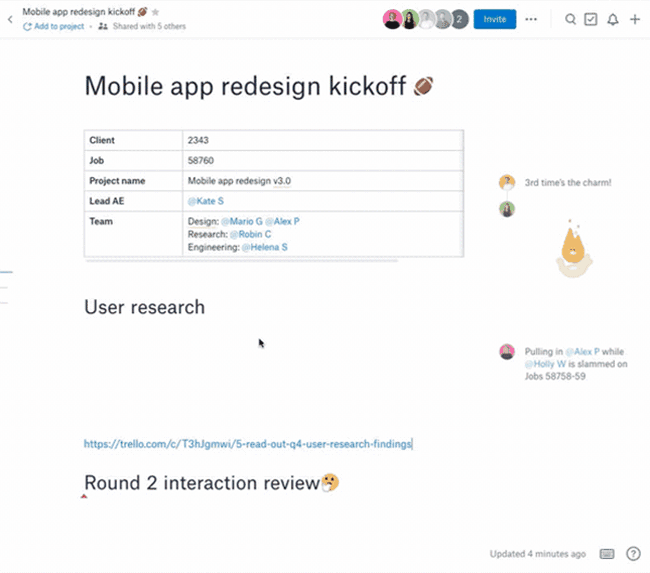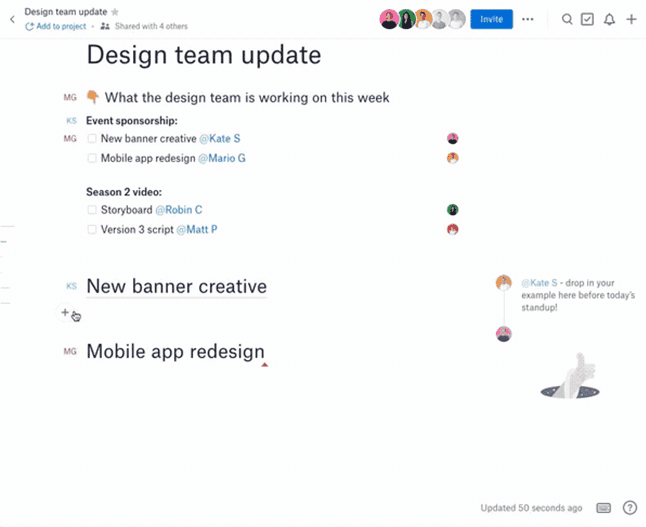
How designers use Dropbox Paper embeds to simplify their workflow
Published on November 13, 2017
If you’re a designer, you work with a lot of tools every day. So many, in fact, that some days it feels like switching between the tools is your second job.
When you’re trying to illustrate the story of an experience you’re creating, though, you rely on each one of those tools for a different reason—whether it’s creating or prototyping.
That’s why designers need a simple way to bring all their tools together in one place. As a designer on the Dropbox Paper team, I know firsthand how Paper’s new integrations have helped make my job easier.
So today, I want to show you they can help your team create and share early ideas.
Embed content from all your tools in one workspace
If you’re new to Dropbox Paper, think of it as the place where your creative vision comes to life. If tools like Dropbox, InVision, or Marvel are where you store your paints, Paper is like your canvas.
It’s like a blank slate for brainstorming, where you can get your ideas down quickly, then invite your team to add their take to the story. Whatever you may be making—from new designs to prototypes—Paper lets you build it together from the beginning.
Start by tapping out a few lines of text describing the project. Then add context by embedding files from the tools you use every day—including Sketch, Figma, InVision, Marvel, and Framer. You can even pull in Adobe Photoshop and Adobe Illustrator files you’ve saved in Dropbox.

Turn reviews into collaborations
Where slide decks tend to feel formal—like you’re creating something finished for someone else to approve—Paper docs maintain the look and feel of a work in progress. They invite your team to do more than review. They encourage them to co-create the next version and contribute new ideas alongside yours. Paper embeds make it easy. Just paste a link in your Paper doc and a preview automatically appears. And by presenting all your media in one doc, you’ll get clearer feedback and avoid the inefficiencies of using screenshots in a slideshow presentation. And Paper lets you display native-level animations in Framer, so whether you’re showing your work in a meeting or at your desk, you can be sure it will run smoothly.
Every tool has its limits—so why limit the tools you can use?
Unlike other solutions, Paper encourages you to use every tool in your box. In addition to the design files mentioned above, you can automagically embed almost any kind of file your team uses to create content, including Microsoft Word, Excel, PPT, PDF, Project tasks in Trello cards—just about any file saved in Dropbox.
One big advantage to having one unified home for all your content is the time you save. With Paper, you get back all of those hours you used to spend searching for information scattered across tools.
Less updating, more creating
Paper lets you avoid the hassle of updating decks every time a change is made. Content you’ve embedded in Paper automatically updates to the latest version whenever you make changes to the source file.
And you can say goodbye to all those long summary emails you used to have to send to every channel where you shared your work. When you work with cross-functional and remote teams, communicating updates in Paper can make your day a lot easier.
Your teammates don’t even need to download Sketch or InVision or Figma to their computer. Paper lets them see embedded images, videos, and file previews right in the doc that’s shared with your team. From design explorations to specs, Paper gives you the flexibility of having a separate doc where everyone has their own space, then makes it easy to bring all docs together for review.
To learn how these integrations can help save time on your next design project, check out Dropbox Paper.















.png/_jcr_content/renditions/hero_square%20(1).webp)

.png/_jcr_content/renditions/hero_wide%20(1).webp)



.png/_jcr_content/renditions/hero_square%20(3).webp)
.png/_jcr_content/renditions/blog%20(1).webp)

.png/_jcr_content/renditions/hero%20(1).webp)
.png/_jcr_content/renditions/hero_wide%20(1).webp)















































.png/_jcr_content/renditions/1080x1080%20(1).webp)










.gif)







































































.png)
.png)
.png)
.jpg)
.jpg)












































































































































































































































































































































































